Abstract
Aiming to diminish the defects caused by high-speed pulsed GMAW (Gas Metal Arc Welding), such as lack of penetration, lack of fusion, humping and undercut, this paper proposes an improved twin-wire GMAW welding process by introducing the impact of additional shielding gas on the molten pool, and the effects of different shielding gas flowrates on the mechanical properties and microstructure of the welded seams were investigated. The purpose of introducing additional shielding gas was to use the airflow hood formed by gas injection to isolate air. The impact force generated by the jet might change the original natural solidification mode of the molten pool, which had the effect of improving weld formation and stirring the pool. The airflow hood formed during the process of the additional shielding gas jet impact welding of the molten pool might extend the protection time for the surface of the welding molten pool. The 2205 duplex stainless steel plate was used as the base material for the butt welding test, and the welded seams were subjected to a tensile test, hardness analysis, and metallographic analysis. The results indicated that as the flowrate of additional shielding gas increased in the range of 8 L/min~16 L/min, the width of the welded seam increased and the height of reinforcement decreased gradually. However, a weld seam with a lower middle region and higher sides would appear when the gas flowrate became excessively large. Under the identical welding current and for welding speeds of 160 cm/min, 180 cm/min and 200 cm/min, respectively, the joint formed under the flowrate of 12 L/min had the highest tensile strength (824.3 MPa) among the test specimens under different flowrates of 8 L/min, 12 L/min and 16 L/min. The test results indicated that the jet impact force was relatively moderate when the flowrate of the additional shielding gas was 12 L/min, and thus was optimal for the welded seam.
1. Introduction
Duplex stainless steel is a type of stainless steel of about half ferrite and half austenite. It is characterized by high toughness, good resistance to pitting, crevice corrosion, stress corrosion and corrosion fatigue. Developments in marine engineering, aeronautics, space, transportation and other industries have greatly promoted the continuous development of welding technology. The enhancement of welding productivity to achieve welding automation and improve welding quality has become a crucial issue in the development of welding technology [1,2,3,4,5]. Twin-wire GMAW welding technology could achieve high speed welding and a good deposition rate, and so has gained much popularity and received much research attention worldwide [6,7,8,9,10]. Twin-wire GMAW welding, where twin-arc acts on the same molten pool, significantly increases the heat input and changes the heat distribution. Sufficient heat on both sides of the molten pool and liquid molten metal are provided. Moreover, under the influence of the mutual heat effect of twin-wire, defects such as undercut and humping can be effectively avoided at higher welding speeds. The welding effect of twin-wire double-pulsed GMAW welding is affected by several parameters such as voltage, current, welding wire, base metal, and welding speed; in particular, the welding speed directly determines the welding production efficiency. Under the conventional conditions of a twin-wire double-pulsed GMAW welding process, although the welding parameters have important effects on the weld quality, it is very difficult to increase the welding speed and improve the weld quality simultaneously while only relying on the adjustment and optimization of welding parameters. As the welding speed increases to a certain value, the weld seam exhibits defects such as a lack of penetration, humping, and undercut [11,12,13,14]. These defects not only lessen the inferior appearance of the weld seam, but also seriously affect the mechanical properties of the welded seam, which is the main reason behind the limitations of the welding speed and efficiency.
To date, research on the mechanism of twin wire welding mainly focuses on the interaction mechanism of twin arc and arc stability, metal transfer mechanism and the stability of twin wire welding [15,16]. Moinuddin et al. [17] found that the reversal phase of the leading and trailing arcs could be used to control the stability of the welding process. The current oscillograms of twin wire double pulsed welding are shown in Figure 1. As the current of the leading arc was greater than that of the trailing arc, the arc stability was better. Wu et al. [18] found that the twin-arc interference of the reversal phase was more serious by investigating the high-current twin-wire pulsed GMAW welding, while the interference behavior significantly reduced when the phases were identical. Ye et al. [19] found that when the trailing arc increased, the leading arc was significantly closer to the trailing arc due to the electromagnetic effect, and the globular transfer mode of the leading arc transited from globular transfer to rotation transfer. With respect to the welding speed, Ueyama et al. [20] found that to ensure good weld seam quality the maximum welding speed should vary between 2 and 3 m/min, which was about 60–150% higher than that of single wire pulse welding. Especially when using the push-angle layout, the welding speed could be increased to 3 m/min. As for the formation and microstructure of the welded seam, Wu et al. [21] found that the difference between the leading and trailing arcs impacted the microstructure, hardness, heat-affected zone, and depth–width ratio of the welded seam. Chen et al. [22] found that the horizontal component of the arc pressure drove fluid to the center of the two arcs, which resulted in the local bulging phenomenon. With the increase in phase difference, the bulged height and seam width gradually decreased when the penetration depth and residual height of the seam increased, thus worsening the appearance. Some researchers have performed a series of explorations on the welding speed of twin-wire GMAW welding. Ueyama et al. [23] analyzed the influencing factors for seam formation during high-speed welding and found that the current, inclination, and twin-wire spacing had significant effects. Starting from the basic requirements to avoid humping and undercut, the optimum process parameters for high-speed welding were obtained at a welding speed of 4.5 m/min. Ueyama et al. [24] studied the effects of twin-wire spacing and gas mixing ratio on the arc interruption and abnormal arc voltage during twin-wire GMAW welding, and reasonable ranges of wire spacing and gas mixing ratio were provided by controlling the arc length and pulse timing of the twin-wire GMAW welding. Ueyama [25] successfully minimized the arc interference and avoided arc interruption. They established a stable welding process control using arc length and confirmed that the stability control was not affected by the fluctuation in extension in wire length and feed speed. In the context of the welding of steel plates in the ship-building industry, Sterjovski et al. [26] proposed a method to reduce the generation of cracks and studied the formation mechanism of solidified cracks in twin-wire GMAW welding. Some researchers have carried out a series of explorations on different shielding gas. Zhang et al. [27] studied the microstructures and properties of DSS 2205 solid wire MIG welded samples prepared in different shielding gases, which were investigated for improving the weldability of the DSS 2205 welded joint, and the strength and corrosion resistance of welded joints were improved more obviously in a 98%Ar + 2%N2 mixed atmosphere. Wang et al. [28] studied mixed shielding gas; increasing nitrogen had little effect on the strength and toughness of the weld. Regardless of the shielding gas used, the base metal was the weakest part of the weld. Lu et al. [29] transformed the traditional TIG welding gun into a double-layer gas channel, with an inert gas protective electrode connected to the inner layer. The outer layer was filled with mixed gas to transition active components to the molten pool, which changed the heat transfer and convection mode of the molten pool and increased the depth of the molten pool.
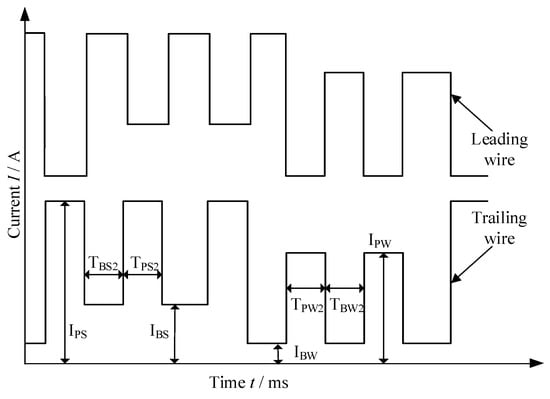
Figure 1.
Current oscillograms of twin-wire double pulsed welding.
On the basis of the conventional twin-wire GMAW welding process, this paper innovatively introduces additional shielding gas. Through the shielding air characteristics and mechanical properties of the gas [30], the effects of twin-wire GMAW welding on the formation mechanical properties and microstructure of the welded seam were studied under the additional shielding gas with different flowrates.
2. Materials and Methods
2.1. Experimental Equipment and Methods
The schematic diagram of twin-wire pulsed GMAW welding under the action of additional shielding gas is described in Figure 2. The welding test platform included lead screws, wire feeding mechanisms, protection devices, automatic walking control mechanisms, data acquisition cards, and arc dynamic wavelet analyzers, which were used to collect real-time signals such as current and voltage, energy input, and dynamic resistance. The additional shielding gas device could better meet the protection requirements of the high-speed welding melt pool by adding three-way gas adjustable valves and adjusting the gas flow meters of branches B and C appropriately. At the same time, an additional electric gas valve 2 and a one-way valve were also installed, which could facilitate valve control. The shielding gas nozzle head also had a protective effect. These can be efficiently combined with existing welding equipment to better meet the requirements of gas flow regulation. The principle of this system is relatively simple. During operation, the gas source at the cylinder enters the electric air valve 1 of the gas supply branch, and then the valve is controlled by a button. During the working process, when welding begins, the gas valve is opened, and shielding gas can enter the corresponding conduit. The conduit and regulating valve A remain connected. The main function of the three-way gas adjustable valve is to regulate the gas from the main circuit and distribute it appropriately. In order to meet the requirements of B and C outlet gas flows and provide appropriate protection, the gas flow of branch C is outputted from C and then controlled to be on or off through gas valve 2. During this process, the airflow sprays from the nozzle cover the newly welded seam, which can provide efficient shielding gas for the weld seam in this area and improve welding quality. The detail of the additional nozzle head is described in Figure 3.
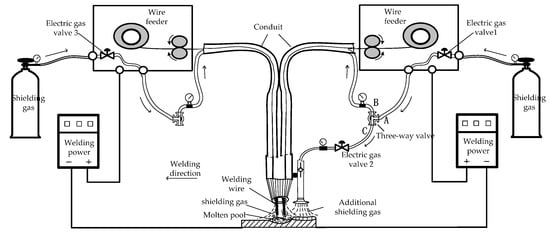
Figure 2.
Schematic diagram of the twin-wire pulsed GMAW welding under different flowrates of additional shielding gas.
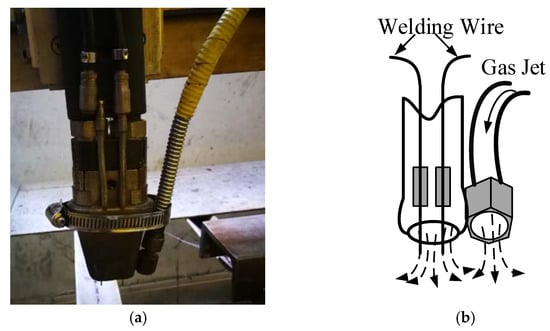
Figure 3.
The detail of the additional nozzle head: (a) welding torch and nozzle head; (b) structural diagram of additional shielding gas nozzle.
2.2. Experimental Materials and Processing
The base material used in the test was a 2205 duplex stainless steel plate with dimensions of 250 mm × 100 mm × 3 mm. The ER2209 wire with a diameter of 1.2 mm was used and the relevant composition of the alloys are shown in Table 1, and the units in the table are percentages. The test conditions were duplex ER2209 stainless steel welding wire with diameter of 1.2 mm undergoing butt welding on the duplex stainless steel plate. The welding process was protected by high-pure argon gas with a set flowrate of 8, 12, 16 L/min, maintaining stable wire feeding. In order to verify the effects of additional shielding gas with different flowrates on the welding process of duplex stainless steel, ten sets of tests were planned during the study. The peak and base current of the leading and trailing wire were 350 A and 120 A. The weld frequency was 3 Hz, and the other weld parameters, such as the flow rate of additional shielding gas and weld speed, are shown in Table 2.

Table 1.
Chemical compositions of 2205 and ER2209 (wt.%).

Table 2.
Main welding parameters of the weld process.
Butt welding with a gap of 1 mm was adopted, and is shown in Figure 4a. The additional shielding gas was argon (Ar) with a purity of 99.99%. Before the welding test, the sample was first mechanically polished to remove the oxides. The surfaces were cleaned with ethanol and the welding started after the surfaces were dried. After welding, a spark discharge wire cutter was used to remove 20 mm from both ends of the welded seam and the specimens for the tensile test and metallographic observation were taken along the direction vertical to the seam. The dimensions of the specimens are displayed in Figure 4b.

Figure 4.
Dimensions of test specimens (unit: mm): (a) draft of plate and all dimensions; (b) specimen for tensile test.
Then, the metallographic sample was mechanically polished and etched, by using aqua regia reagent to continuously corrode for 25 s, then flushed with water and dried with an air blower. The microstructure characteristics of welded joints were analyzed using optical microscopy Olympus (OM, Ishikawa, Japan) and scanning electron microscopy (Hitachi, Tokyo, Japan). A Vickers micro-hardness test was conducted on the polished and etched specimens with a testing time of 15 s per test point, a load of 200 g, and a step size of 1 mm. A room temperature tensile test was carried out on an INSTRON tester (INSTRON, Norwood, MA, USA), and the tensile tests of the joints were carried out following ASTM E8 at a crosshead speed 3 mm/min, and 3 specimens were tested for each welded joint. After the tensile test, the fracture morphology of the welded joint was observed using SEM according to the standard GB/T30834-2014.
3. Results
3.1. Formation of the Weld Seam
It can be seen from Figure 5 that the seam exhibited an overall uniform and flat morphology, which clearly manifested the improvement of additional shielding gas on the shaping process of the welded seam. In this paper, D is weld depth, W is weld width, and D/W is the ratio of weld depth and weld width. It can be seen from Figure 6 that under an identical welding speed and current the higher flowrate of the additional shielding gas produced a wider welding seam, deeper penetration depth, and smaller aspect ratio (depth/width). The appearance of the seam formed under the additional shielding gas changes and the specific dimensions of the seam is displayed in Figure 7. As the flowrate of the gas increased, the width of the seam increased gradually and the residual height gradually decreased, since the different flowrates of additional shielding gas brought variation in the impact force acting on the welded seams. When the flowrate of the additional shielding gas was 12 L/min, the impact force of the jet was more suitable for the set of welding parameters that best improved the welded seam. The shape of the obtained welds varied greatly and the morphologies of welds formed with an additional shielding gas flowrate of 12 L/min were obviously superior to those with shielding gas flowrates of 0 L/min, 8 L/min, and 16 L/min, and the surface of the weld seam was relatively smooth and uniform. The weld surface exhibited an obvious fish-scale-like weld seam. It can be concluded from Figure 7j that the part of the weld bead without additional shielding gas had an unevenly curved formation, and the weld was narrow and the penetration depth was insufficient, indicating the poor formation of the weld seam. The impact force generated by the gas under a flowrate of 8 L/min was slightly smaller and the improvement on the seam was not as good as that under the gas flowrate of 12 L/min. When the gas flowrate was 16 L/min, the over-protection phenomenon of the gas jet occurred on the welded seam. Under an excessively large flowrate of additional shielding gas, the seam had a grooved morphology with a lower middle part and higher sides, which indicates that the impact force of the jet exceeds the actual requirement of the liquid pool significantly [31]. The reason for the formation is that the molten pool becomes depressed under the excessive impact force acting on the molten pool. The liquid–solid phase transition was completed before the metal bulging on both sides recovered to the middle region, so the metal exhibited a grooved shape after the solidification was completed. At the same time, a small amount of drop-shaped metal particles dispersed on both sides of the seams in tests #7, #8, and #9. Due to the excessive gas jet, a portion of the liquid metal separated from the molten pool and splashed on the surface of the base material under a strong impact force, and then formed metal particles [32]. It can be seen from Figure 7j that Sample 10 had obvious incomplete fusion defects without the additional shielding gas.

Figure 5.
The weld shape and joints section.
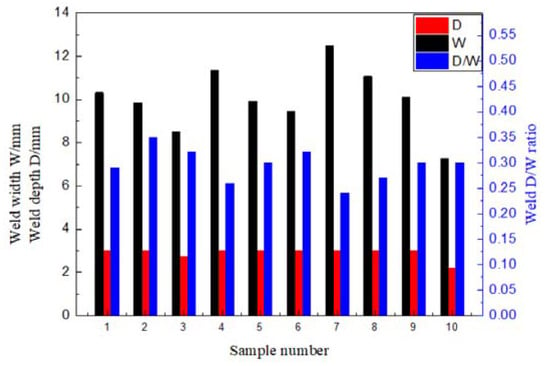
Figure 6.
Weld depth, weld width, and weld D/W ratio.
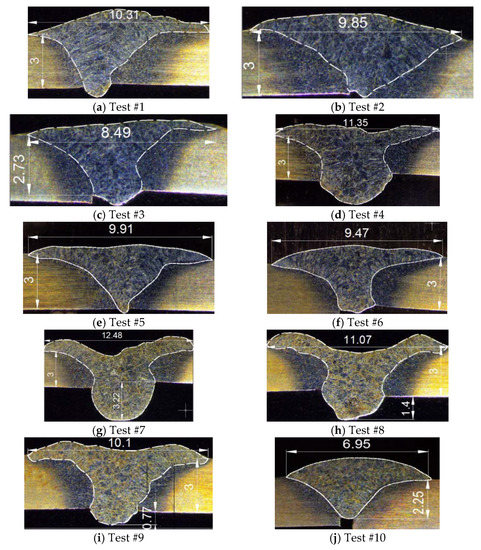
Figure 7.
Morphology of the weld seam (unit: mm).
3.2. Results of Metallographic Tests
The fusion zone (FZ), heat-affected zone (HAZ), and base metal (BM) of the welded seams of the nine samples were analyzed and the microstructure of the HAZ was observed at 50× magnification, as shown in Figure 8. The HAZ widths between the weld seam and the 2205 base metal in tests #1, #2, and #3 were 500~1600 μm, 400 μm~1000 μm, and 300 μm~500 μm, respectively. The HAZ widths in tests #4, #5, and #6 tests were 150 μm~1000 μm, 300 μm~800 μm, and 150 μm~400 μm, narrower than those in tests #1, #2, and #3, respectively. The HAZ widths in tests #7, #8, and #9 were 400 μm~1500 μm, 300 μm~1200 μm, and 200 μm~1000 μm, respectively, wider than those in tests #4, #5, and #6. It can be seen that when the flowrate of additional shielding gas was 12 L/min (#4, #5, and #6), the HAZ range was the smallest, followed by the HAZ range corresponding to the additional shielding gas flowrate of 8 L/min (#1, #2, and #3). The HAZ range under the additional shielding gas with a flowrate of 16 L/min (#7, #8, and #9) was the largest. After introducing additional shielding gas with different flowrates, the flowability of the molten metal in the pool under a larger gas flowrate (12 L/min) was better than that under 8 L/min, indicating a greater driving force of the metal diffusion and a shorter liquid residence time, so that the HAZ was narrower than that under the smaller flowrate of the additional shielding gas. However, if the flowrate of the additional shielding gas was too large (16 L/min), the molten pool could become depressed under the impact force and the downward flow of metal would be obvious. The metal takes on a grooved shape after being completely solidified, which obviously influences the shape of the molten pool. Since the metal bulge that flows downwards is significant, it is difficult for this portion of the metal to undergo heat transfer. The resultant slower heat dissipation causes the HAZ range under the excessive flowrate of the additional shielding gas to be larger than that under the smaller flowrate of the additional shielding gas. In general, regardless of the flowrate of the additional shielding gas, the HAZ formed under higher welding speed was narrower than that under lower welding speed; for instance, the HAZ ranges in tests #3, #6, and #9 were narrower than those in tests #2, #5, and #8. In #10, a heat-affected zone of 200–1200 μm width was shown in Figure 8j, while the heat-affected zone with 300–800 μm width in #5, as shown in Figure 8e, was narrower than that of the heat-affected zone. This was because the fluidity of the molten pool metal in the presence of additional shielding gas was better than that without additional gas due to the action of the external gas flow. The better fluidity provides more driving force for the diffusion of the metal and a shorter residence time in the liquid state, and so the extent of its heat-affected zone is smaller than that of the weld seam without additional shielding gas.
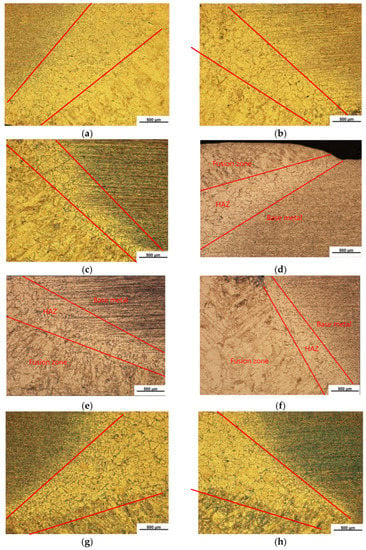
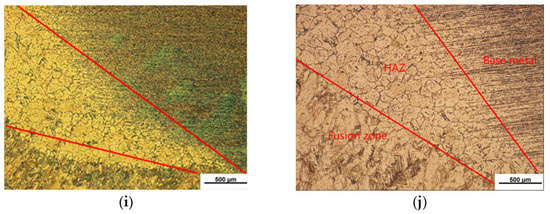
Figure 8.
Metallographic test results of heat-affected zone (HAZ): (a) metallographic image of HAZ in test #1, (b) metallographic image of HAZ in test #2, (c) metallographic image of HAZ in test #3, (d) metallographic image of HAZ in test #4, (e) metallographic image of HAZ in test #5, (f) metallographic image of HAZ in test #6, (g) metallographic image of HAZ in test #7, (h) metallographic image of HAZ in test #8, (i) metallographic image of HAZ in test #9, (j) metallographic image of HAZ in test #10.
The microstructure of the seam was observed with 50× magnification. The welded seam showed obvious dendritic structures, most of which were austenite. These austenite structures were feathery and amounted to a relatively higher proportion. Most austenite became distributed in the grain boundaries and ferrite grains. It can be seen from Figure 9 that there were more Wei’s body structures in the welded seam, and the brittleness of the metal in the molten pool also increased significantly. Experimental results suggested that the grains of the fusion zones in tests #1, #2, and #3 were obviously coarser than those in tests #4, #5, and #6. The grains of the fusion zones in tests #7, #8, and #9 were coarser than those in tests #4, #5, and #6. Because the flowrates of the additional shielding gas in tests #1, #3, and #5 were smaller, so the flowability of metal was poorer and the residence time of liquid metal was longer. This could increase the proportion of austenite in the fusion zone and increase the brittleness of the metal in the molten pool, resulting in the hardness and toughness of the material in tests #1, #2, and #3 being worse than those in tests #4, #5, and #6. When the welding speed increased, the grain size of the fusion zone also increased to a certain extent. The reason is that when the welding line energy increased, the corresponding weld cooling rate reduced and the secondary dendrite spacing obviously increased, which easily formed a coarser structure. Moreover, under the influence of heat input, the metal of the welded seam would be in a high-temperature state for a long time, and the quantity of heat transferred under the action of the temperature also increased. This could promote the migration of the grain boundary [33]. The grain size in the weld fusion zone in #10 was obviously coarser and larger than that of the #5, as shown in Figure 5i,j. Due to the lack of additional shielding gas, the metal had poorer fluidity and the liquid metal had a longer residence time. As a result, the austenite in the fusion zone continued to increase, which led to the brittleness of the weld pool metal.

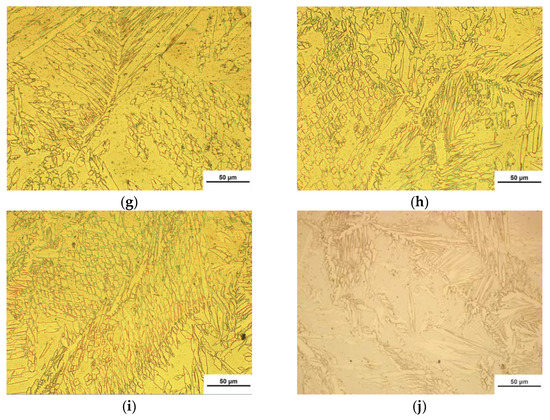
Figure 9.
Metallographic test results of weld metal: (a) metallographic image of fusion zone in test #1, (b) metallographic image of fusion zone in test #2, (c) metallographic image of fusion zone in test #3, (d) metallographic image of fusion zone in test #4, (e) metallographic image of fusion zone in test #5, (f) metallographic image of fusion zone in test #6, (g) metallographic image of fusion zone in test #7, (h) metallographic image of fusion zone in test #8, (i) metallographic image of fusion zone in test #9, (j) metallographic image of fusion zone in test #10.
3.3. Welding Electrical Signal Results
The current oscillograms obtained using the wavelet analyzer under different flow rates when introducing additional shielding gas are displayed in Figure 10. At flow rates of 8 L/min and 12 L/min, there were small changes in the amplitude of the current before and after introducing additional shielding gas, and the consistency was good. As the gas flow rate increased, the reaction force of the arc on the molten metal in the molten pool intensified, and it was difficult to maintain the stability of the welding process. Due to the jet effect generated by the additional shielding gas, it interfered with the trailing wire, thus exacerbating the impact on the current amplitude, resulting in a significant change in the impact of the trailing wire current. From the Figure 10, it can be seen that the main influencing factors of welding input energy were the instantaneous arc current and voltage, and their magnitude was related to the length of the arc. In this welding mode, the pulse power varied with the pulse waveform of the current and voltage, and the power change range corresponding to rectangular wave modulation pulse welding was 4–14 kW.
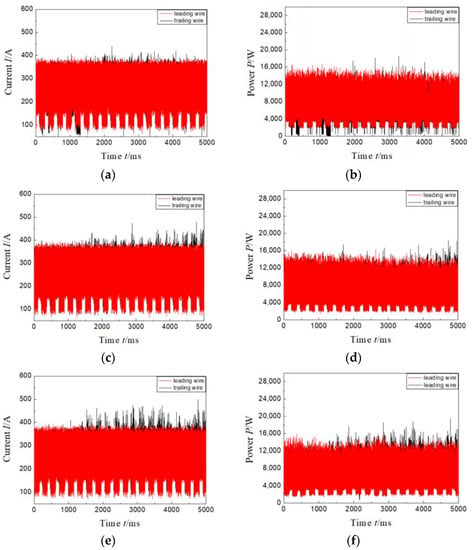
Figure 10.
Welding current and power oscillograms: (a) welding current oscillograms with flow rates of 8 L/min, (b) welding power oscillograms with flow rates of 8 L/min, (c) welding current oscillograms with flow rates of 12 L/min, (d) welding power oscillograms with flow rates of 12 L/min, (e) welding current oscillograms with flow rates of 16 L/min, (f) and welding power oscillograms with flow rates of 16 L/min.
3.4. Hardness Test Result
The results of the Vickers hardness test for the seam under additional shielding gas with different flowrates are shown in Figure 11. It can be observed that the Vickers hardness of the heat-affected zone metal was higher than that of base metal and weld metal, and the hardness of the weld metal was higher than that of base metal. The reason may be that the grain distribution in the heat-affected zone was not uniform, and it was easy to form welding residual stress in the welding process, resulting in the increase in hardness. It can be seen that the Vickers hardness of the seam formed under the flowrate of 12 L/min was slightly higher than that under the flowrate of 8 L/min, which indicates that an increase in the flowrate of the additional shielding gas was advantageous in increasing the hardness of the joints. This phenomenon occurs because the higher flowrate of the additional shielding gas increased the temperature gradient of the joints and accelerated heat dissipation, thereby endowing the joints with a higher hardness. The Vickers hardness of the welded seam under the additional shielding gas flowrate of 12 L/min was slightly higher than that under the flowrate of 16 L/min. This was because the excessive flowrate made the molten pool depressed under the impact force and the metal flowed downward obviously. The hardness of the weld without the additional shielding gas was generally lower than that under the additional shielding gas, which indicates that the introduction of the additional shielding gas was beneficial for enhancing the hardness of the joint. The phenomenon may have been due to the introduction of additional shielding gas increasing the temperature gradient of the joints and accelerating the heat dissipation at the joints. Due to the obvious bulging phenomenon of the metal flowing downward, it is difficult for the portion of the metal to transfer heat to the additional shielding gas. The slower heat dissipation of metal resulted in the coarse seam structure and then led to the lower hardness of the joint.
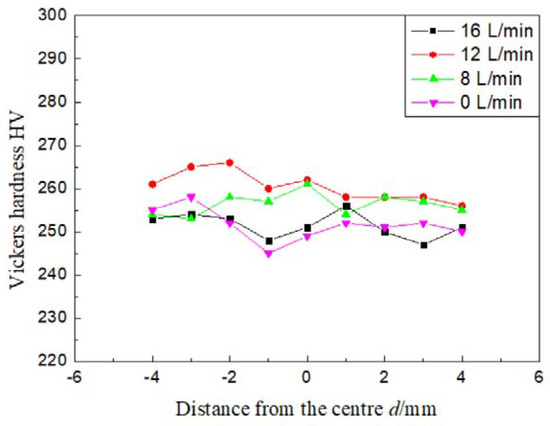
Figure 11.
The Vickers hardness in welded joints.
3.5. Mechanical Properties
The tensile strength and fracture situations of the seams are shown in Table 3. The analysis of the test results in Table 3 indicated that the fracture positions in tests #1, #2, #4, #5, and #8 all appeared on the side of the base metal, and the tensile strengths of the welded seams were higher than those of the base metal. The fracture positions in tests #3, #6, #7, #9 and #10 appeared at the welded seams, indicating that the strengths of the welded seams were lower than that of the base metal. On considering the fracture positions of the welded seam simultaneously, the analysis indicated that the tensile strength of the welded seam was mainly affected by the cross-section shape of the seam. The seam with lower penetration could not withstand the high ultimate load, and so the fracture probabilities were also higher. However, the problem did not occur in the tensile test of the seam with better fusion.

Table 3.
Tensile strength of weld joint.
The tensile test results of the joints are shown in Figure 12, Figure 13, Figure 14 and Figure 15. The maximum tensile strengths of specimens #1~#10 were 734.21 MPa, 796.7 MPa, 728.47 MPa, 797.65 MPa, 824.3 MPa, 718.76 MPa, 793.05 MPa, 795.04 MPa, 555.84 MPa, and 649.05 MPa, respectively. This was under the identical welding current and for welding speeds of 160 cm/min, 180 cm/min, and 200 cm/min, respectively. The joint formed under the flowrate of 12 L/min had the highest tensile strength among the test specimens under different flowrates of 8 L/min, 12 L/min, 16 L/min, and 0 L/min. The morphologies of the tensile-fractured sections are shown in Figure 16 for when the welding speed was 180 cm/min. The fracture section of the weld seam formed under the flowrate of 8 L/min was a transgranular fracture along the cleavage planes, and thus can be classed as a brittle fracture; the fracture section of the weld seam formed under the flowrate of 12 L/min contained a large number of dimples. There was a certain amount of inclusion at the bottom of these dimples [34], indicating that the fracture belonged to the ductile regime. The fracture section of the seam formed under a flowrate of 16 L/min and without additional shielding gas was a transgranular fracture along the cleavage plane, indicating that it belonged to the brittle fracture.
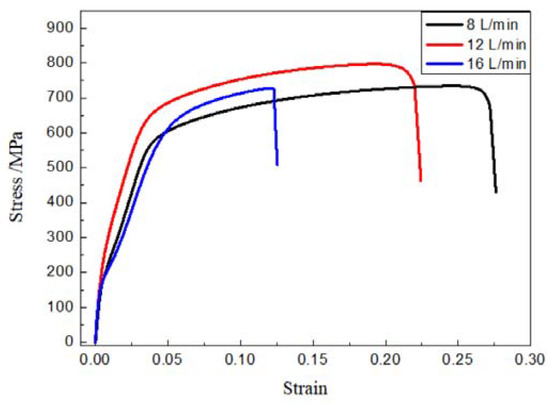
Figure 12.
Comparison of tensile results of weld with different flow rates at 160 cm/min speed.
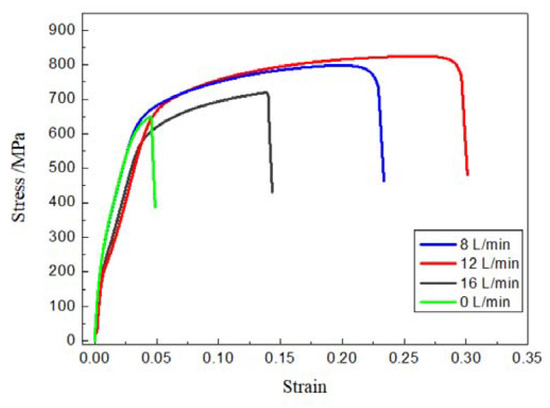
Figure 13.
Comparison of tensile results of weld with different flow rates at 180 cm/min speed.
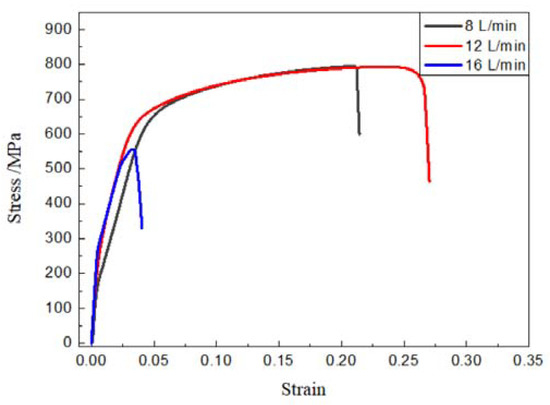
Figure 14.
Comparison of tensile results of weld with different flow rates at 200 cm/min speed.
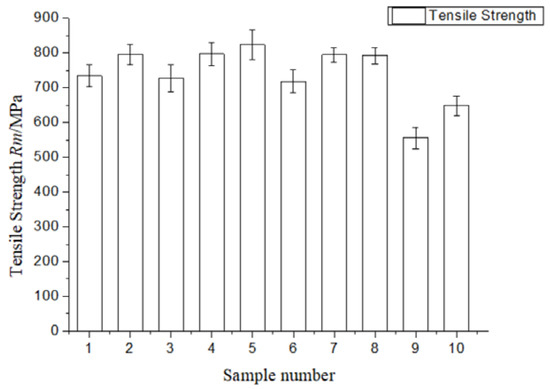
Figure 15.
Tensile properties of the welded joints.
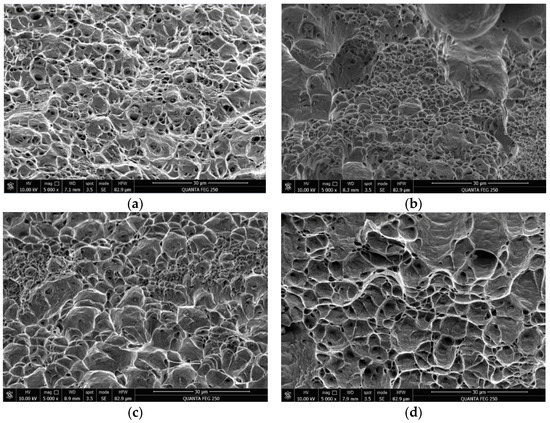
Figure 16.
Tensile section diagrams of different additional shielding gas flowrates: (a) 8 L/min; (b) 12 L/min; (c) 16 L/min; and (d) 0 L/min.
4. Discussion
In conclusion, research on the effect of shielding gas has been undertaken, but specialized research and the introduction of additional shielding gas onto welding molten pools are still in the exploration stage. From the analysis and research of relevant scientific and technological efforts, it can be seen that some scholars have observed certain effects of shielding gas on weld formation from different perspectives. In addition, from the perspective of study, the effect of the application of an additional shielding gas jet in a welding molten pool should essentially be on the impact behavior of the gas jet on the liquid metal molten pool, which should be attributed to the physical phenomenon of gas–liquid two-phase flow interaction under special conditions. The most obvious effect of the compensating gas jet was to greatly improve the appearance and morphology of the weld seam, significantly decreasing defects such as humps and undercuts which occurred in conventional high-speed welding. Moreover, it can greatly improve the flatness, uniformity, and consistency of the weld seam.
From the formation and appearance of the weld seam, when the flowrate of the gas increased, the width of the seam increased gradually and the residual height gradually decreased. At flow rates of 8 L/min, the weld was narrow and the penetration depth was insufficient; As the gas flowrate was 16 L/min, the over-protection phenomenon of the gas jet occurred on the welded seam, and the seam had a grooved morphology with a lower middle part and higher sides. As the flowrate of the additional shielding gas was 12 L/min, the impact force of the jet was more suitable for the set of welding parameters that best improved the welded seam. From the metallographic results, when the flowrate of the additional shielding gas was 12 L/min, the HAZ range was the smallest, owing to the fluidity of the molten pool metal in the presence of additional shielding gas being better than other conditions. From the Vickers hardness results, the Vickers hardness of the seam formed under the flowrate of 12 L/min was slightly higher than other conditions; this was because the higher flowrate gas increased the temperature gradient of the joints and accelerated heat dissipation in the joint. The joint which formed under the flowrate of 12 L/min had the highest tensile strength (824.3 MPa) among the test specimens under different flowrates of the additional shielding gas. In summary, for the formation mechanical properties and microstructure of the welded seam, the flowrate of the additional shielding gas of 12 L/min was optimal for the welded seam. Excessive flowrate (16 L/min) made the molten pool depressed under the impact force and the metal flowed downward, while too small a flowrate (8 L/min) led to defects of a lack of penetration and fusion.
5. Conclusions
After introducing additional shielding gas with different flowrates, the twin-wire pulsed GMAW high-speed welding could achieve the following benefits:
- (1)
- Under the appropriate gas flowrate, using an additional shielding gas jet, the surface of the weld seam was relatively smooth and uniform; the incomplete fusion defects of the weld seam could be effectively improved and diminished.
- (2)
- As the flowrate of the additional shielding gas was 12 L/min, the impact force caused by the jet was optimal for the set of welding parameters, thus resulting in the good improvement of the welded seam. The heat-affected zone was smaller than that of the weld seam formed with the additional shielding gas flowrates of 8 L/min, 16 L/min, and 0 L/min. Under the identical welding current and for welding speeds of 1.6 m/min, the joints formed under the flowrate of 12 L/min had the highest tensile strength (796.7 MPa) among the test specimens under different flowrates of 8 L/min, 12 L/min, 16 L/min. Under the welding speeds of 1.8 m/min, the joints formed under the flowrate of 12 L/min had the highest tensile strength (824.3 MPa) among all the test specimens. Under welding speeds of 2.0 m/min, the joints formed under the flowrate of 12 L/min had the highest tensile strength (795.04 MPa) among the test specimens under different flowrates of 8 L/min, 12 L/min, and 16 L/min.
- (3)
- The impact force generated by the flowrate of 8 L/min was slightly smaller, so the improvement effect was worse than that under the flowrate of 12 L/min. As the flowrate was 16 L/min, the excessive gas flowrate of the gas jet occurred on the welded seam, and the welded seam exhibited a grooved morphology, so that the middle region was lower and the two sides were higher.
Author Contributions
Funding acquisition, Y.H.; writing—original draft, Y.H.; formal analysis, Y.H.; resources, Y.H.; data curation, Y.H.; investigation, Y.H.; visualization, Y.H.; conceptualization, J.X.; methodology, J.X.; supervision, J.X. All authors have read and agreed to the published version of the manuscript.
Funding
This research received funding from the Major Science and Technology Plan of Hainan Province (Grant No. ZDKJ2021013), Hainan Province Science and Technology Special Fund (Grant No. ZDYF2021XDNY305, ZDYF2023XDNY066), the National Key R&D Program of China (Grant No. 2019YFD0900903), and the Modern Agriculture (FISH) Industrial Technology Special Fund System (CARS-47-Z16).
Data Availability Statement
Data sharing not applicable; all the data created for this study are already displayed in the article.
Conflicts of Interest
The authors declare no conflict of interest.
References
- Abdo, H.S.; Seikh, A.H. Mechanical properties and microstructural characterization of laser welded S32520 duplex stainless steel. Materials 2021, 14, 5532. [Google Scholar] [CrossRef]
- Ding, L.Z.; Meng, Q.S.; Yang, Z.; Wang, G. Effects of the welding process on mechanical properties and corrosion resistance of 2205 duplex stainless steel. Adv. Mater. Res. 2011, 189–193, 1212–1217. [Google Scholar] [CrossRef]
- Łabanowski, J.; Fydrych, D.; Rogalski, G.; Samson, K. Underwater welding of duplex stainless steel. Solid. State. Phenom. 2011, 183, 101–106. [Google Scholar] [CrossRef]
- Shu, C.; Shu, P.; Pang, D.; Zhang, Q.; Zhang, Z. Numerical simulation and experimental investigation on 2205 duplex stainless steel K-TIG welded joint. Metals 2021, 11, 1323. [Google Scholar]
- Hu, Y.; Shi, Y.; Wang, K.; Huang, J. Effect of heat input on the microstructure and mechanical properties of local dry underwater welded duplex stainless steel. Materials 2023, 16, 2289. [Google Scholar] [CrossRef] [PubMed]
- Shi, Y.; Cui, S.; Zhu, T.; Gu, S.; Shen, X. Microstructure and intergranular corrosion behavior of HAZ in DP-TIG welded DSS joints. J. Mater. Process. Technol. 2018, 256, 254–261. [Google Scholar] [CrossRef]
- Arabi, S.; Pouranvari, M.; Movahedi, M. Pathways to improve the austenite–ferrite phase balance during resistance spot welding of duplex stainless steels. Sci. Technol. Weld. Join. 2018, 5, 8–15. [Google Scholar] [CrossRef]
- Emami, S.; Saeid, T.; Khosroshahi, R.A. Microstructural evolution of friction stir welded SAF 2205 duplex stainless steel. J. Alloys Compd. 2018, 739, 678–689. [Google Scholar] [CrossRef]
- Krasnorutskyi, S.; Kipp, C.; Hensel, J.; Kaestner, P.; Hartwig, S.; Bräuer, G.; Dilger, K. Metallurgical investigation of electron beam welded duplex stainless steel X2CrNiMoN22-5-3 with plasma nitrided weld edge surfaces. Mater. Test. 2018, 60, 577–582. [Google Scholar] [CrossRef]
- Ye, D.; Hua, X.; Zhang, J.; Wu, Y.; Bai, Y. Analysis of arc interference and welding stability in twin wire GMAW welding. Int. J. Adv. Manuf. Technol. 2015, 81, 627–633. [Google Scholar] [CrossRef]
- Hu, Y.; Xue, J.; Dong, C.; Jin, L.; Zhang, Z. Effects of additional compensation shielding gas on high-speed pulsed MIG welding seams. Trans. China Weld. Inst. 2015, 36, 85–88. [Google Scholar]
- Hu, Y.; Xue, J.; Dong, C.; Jin, L.; Zhang, Z. Effect of additional shielding gas on welding seam formation during twin wire DP-MIG high-speed welding. Appl. Sci. 2018, 9, 1658. [Google Scholar] [CrossRef]
- Berna, C.; Juliá, J.E.; Escrivá, A.; Muñoz-Cobo, J.L.; Pastor, J.V.; Micó, C. Experimental investigation of the entrained droplet velocities in a submerged jet injected into a stagnant water pool. Exp. Therm. Fluid Sci. 2017, 82, 32–41. [Google Scholar] [CrossRef]
- Mordasov, M.M.; Savenkov, A.P.; Chechetov, K.E. Method for analyzing the gas jet impinging on a liquid surface. Technol. Phys. 2016, 61, 659–668. [Google Scholar] [CrossRef]
- Kim, S.Y.; Lee, H.S.; Park, J.H. Deposition of different metallic coatings as repair materials for concrete by using a twin-wire arc thermal spray process. Appl. Sci. 2022, 12, 11874. [Google Scholar] [CrossRef]
- Milz, M.P.; Wirtz, A.; Abdulgader, M.; Biermann, D.; Tillmann, W.; Walther, F. Fatigue assessment of twin wire arc sprayed and machine hammer-peened ZnAl4 coatings on S355 JRC+C substrate. Materials 2022, 15, 1182. [Google Scholar] [CrossRef]
- Moinuddin, S.Q.; Sharma, A. Arc stability and its impact on weld properties and microstructure in anti-phase synchronised synergic-pulsed twin-wire gas metal arc welding. Mater. Des. 2015, 67, 293–302. [Google Scholar] [CrossRef]
- Wu, K.Y.; He, Z.W.; Liang, Z.Y.; Cheng, J. The dynamic behavior of double arc interference in high-power double wire pulsed GMAW. Int. J. Adv. Manuf. Technol. 2016, 88, 2795–2802. [Google Scholar] [CrossRef]
- Ye, D.; Hua, X.; Xu, C.; Li, F. Research on arc interference and welding operating point change of twin wire MIG welding. Int. J. Adv. Manuf. Technol. 2017, 89, 493–502. [Google Scholar] [CrossRef]
- Ueyama, T.; Ohnawa, T.; Tanaka, M.; Nakata, K. Effects of torch configuration and welding current on weld bead formation in high speed tandem pulsed gas metal arc welding of steel sheets. Sci. Technol. Weld. Join. 2013, 10, 750–759. [Google Scholar] [CrossRef]
- Wu, C.S.; Hu, Z.H.; Zhong, L.M. Prevention of humping bead associated with high welding speed by double-electrode gas metal arc welding. Int. J. Adv. Manuf. Technol. 2012, 63, 573–581. [Google Scholar] [CrossRef]
- Chen, D.S.; Chen, M.A.; Wu, C.S. Effects of phase difference on the behavior of arc and weld pool in tandem P-GMAW. J. Mater. Process. Technol. 2015, 225, 45–55. [Google Scholar] [CrossRef]
- Ueyama, T.; Ohnawa, T.; Tanaka, M.; Nakata, K. Effect of welding current on high speed welding bead formation in tandem pulsed GMA welding process. Welding. Int. 2006, 20, 262–267. [Google Scholar] [CrossRef]
- Ueyama, T.; Ohnawa, T.; Tanaka, M.; Nakata, K. Occurrence of arc interaction in tandem pulsed gas metal arc welding. Sci. Technol. Weld. Join. 2007, 12, 523–529. [Google Scholar] [CrossRef]
- Ueyama, T.; Ohnawa, T.; Tanaka, M.; Nakata, K. Solution to problems of arc interruption and arc length control in tandem pulsed gas metal arc welding. Sci. Technol. Weld. Join. 2009, 14, 305–314. [Google Scholar] [CrossRef]
- Sterjovski, Z.; Bayley, C.; Donato, J.; Lane, N.; Lang, D. Weld-End solidification cracking in pulsed-tandem gas metal arc welding of naval steels. Weld. J. 2014, 93, 145–152. [Google Scholar]
- Zhang, X.Y.; Zha, X.Q.; Gao, L.Q.; Hei, P.H.; Ren, Y.F. Influence of shielding gas on microstructure and properties of GMAW DSS2205 welded joints. Materials 2021, 14, 2671. [Google Scholar] [CrossRef]
- Wang, K.; Shao, C.; Jiao, X.; Zhu, J.; Cai, Z.; Li, C. Investigation on microstructure and properties of duplex stainless steel welds by underwater laser welding with different shielding Gas. Materials 2021, 14, 4774. [Google Scholar] [CrossRef]
- Lu, S.P.; Li, D.J.; Li, D.Z.; Li, Y.Y. Double shielded TIG welding method. Trans. China Weld. Inst. 2010, 31, 21–24. [Google Scholar]
- Schricker, K.; Baumann, A.; Bergmann, J.P. Local shielding gas supply in remote laser beam welding. J. Manuf. Mater. Process. 2021, 5, 139. [Google Scholar] [CrossRef]
- Silwal, B.; Pudasaini, N.; Roy, S.; Murphy, A.B.; Nycz, A.; Noakes, M.W. Altering the supply of shielding gases to fabricate distinct geometry in GMA additive manufacturing. Appl. Sci. 2022, 12, 3679. [Google Scholar] [CrossRef]
- Palanisamy, V.; Solberg, J.K.; Moe, P.T. Shielded active gas forge welding of an L80 steel in a small scale shielded active gas forge welding machine. J. Manuf. Mater. Process. 2021, 5, 16. [Google Scholar] [CrossRef]
- Ding, R.; Yao, J.; Du, B.; Li, K.; Li, T.; Zhao, L.; Guo, Y. Effect of shielding gas volume flow on the consistency of microstructure and tensile properties of 316L manufactured by selective laser melting. Metals 2021, 11, 205. [Google Scholar] [CrossRef]
- Lohse, M.; Trautmann, M.; Füssel, U.; Rose, S. Influence of the CO2 content in shielding gas on the temperature of the shielding gas nozzle during GMAW welding. J. Manuf. Mater. Process. 2020, 4, 113. [Google Scholar] [CrossRef]
Disclaimer/Publisher’s Note: The statements, opinions and data contained in all publications are solely those of the individual author(s) and contributor(s) and not of MDPI and/or the editor(s). MDPI and/or the editor(s) disclaim responsibility for any injury to people or property resulting from any ideas, methods, instructions or products referred to in the content. |
© 2023 by the authors. Licensee MDPI, Basel, Switzerland. This article is an open access article distributed under the terms and conditions of the Creative Commons Attribution (CC BY) license (https://creativecommons.org/licenses/by/4.0/).









